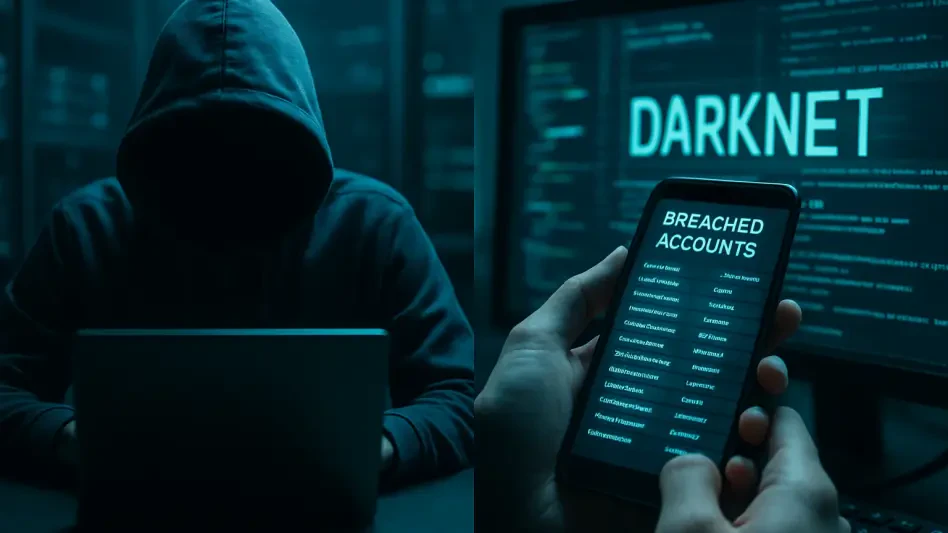Imagine a hidden corner of the internet where stolen personal information is bought and sold like everyday commodities, with countless individuals completely unaware that their passwords, email addresses, and even financial details are up for grabs. This shadowy realm, often referred to as the darknet, operates beyond the reach of standard search engines and poses a significant threat to digital security. Every day, data breaches expose sensitive information, which then circulates in these underground marketplaces, putting unsuspecting users at risk of identity theft or financial loss. While the idea of checking for compromised data might seem daunting, a straightforward and little-known tool exists to help uncover whether personal information has been exposed. This article delves into the nature of the darknet, reveals how to use a simple feature to scan for leaked data, and provides actionable steps to safeguard digital identities from potential harm.
1. Understanding the Darknet and Its Risks
The darknet is a concealed segment of the internet, accessible only through specialized software like Tor, and it remains invisible to conventional search engines. It serves as a hub for various activities, including the trade of illicit goods and stolen data, where personal details such as login credentials, phone numbers, and banking information are often sold to the highest bidder. After a data breach, this information frequently ends up on darknet marketplaces, leaving individuals vulnerable to account takeovers or fraudulent transactions. The anonymity of this environment makes it challenging to track perpetrators, amplifying the danger for those whose data is compromised. Awareness of these risks is crucial, as many remain oblivious to the fact that their information could already be circulating in these hidden spaces, ready to be exploited by malicious actors without their knowledge.
Unlike common misconceptions that only high-profile targets face such threats, the reality is that anyone with an online presence can become a victim of data exposure on the darknet. Small-scale breaches or even phishing attacks can lead to personal information being harvested and traded, often without immediate signs of compromise. The impact can range from unauthorized access to social media accounts to severe financial losses if banking details are involved. Studies indicate that millions of credentials are leaked annually, with many users remaining unaware until significant damage occurs. Recognizing the pervasive nature of this issue highlights the importance of proactive monitoring. By understanding how the darknet operates as a marketplace for stolen data, individuals can better appreciate the urgency of checking for exposure and taking preventive measures to secure their digital lives.
2. Discovering Exposure with a Hidden Tool
Hidden within the settings of a widely used online account platform is a powerful feature that scans for personal data on the darknet, yet many users are unaware of its existence. This tool, often labeled as a dark web report, is accessible through the security section of a Google Account and checks if email addresses or other linked information appear in known breaches. Activating this scan takes just a few clicks, and the results provide a clear overview of any matches found in darknet databases. If a hit is detected, the report also offers tailored recommendations to mitigate risks. Though availability might differ based on region or account settings, this feature serves as an essential starting point for anyone concerned about data leaks in hidden online spaces.
Running this scan regularly can reveal vulnerabilities before they escalate into serious issues, offering peace of mind in an era of frequent cyberattacks. The process is user-friendly, requiring no technical expertise, and delivers results almost instantly, making it accessible to a broad audience. Beyond identifying compromised data, the tool often points to specific accounts or services that may have been affected, allowing for targeted action. However, it’s important to note that this feature may not detect every instance of exposure, as new breaches occur constantly, and not all darknet data is cataloged. Supplementing this scan with other security practices ensures a more comprehensive defense. By leveraging such built-in tools, users gain a critical first line of insight into potential threats lurking in the unseen corners of the internet.
3. Steps to Take After Detecting a Breach
If a dark web report confirms that personal data has been exposed, swift action is vital to minimize potential damage and prevent further exploitation. Start by updating passwords for any affected accounts, ensuring they are strong, unique, and unrelated to previously used combinations. Enabling two-factor authentication adds an extra layer of protection, making it harder for unauthorized parties to gain access even if credentials are stolen. Monitoring financial statements for suspicious activity is also essential, as leaked banking information can lead to fraudulent charges. Additionally, using a password manager can help maintain secure and distinct login details across multiple platforms, reducing the risk of widespread compromise from a single breach.
Beyond immediate fixes, consider notifying relevant institutions, such as banks or service providers, about the exposure to ensure they are on alert for unusual activity. Reviewing privacy settings on social media and other online accounts can limit the amount of personal information visible to potential attackers. It’s also wise to remain vigilant for phishing attempts, as cybercriminals often exploit leaked data to craft convincing scams. Regularly checking for updates on the breach through reputable sources can provide insight into its scope and any further risks. Taking these steps not only addresses the current issue but also builds resilience against future threats. By acting decisively, the impact of data exposure on the darknet can be significantly curtailed, protecting both personal and financial security.
4. Building Long-Term Digital Defenses
Maintaining robust digital security requires ongoing effort beyond reacting to immediate threats, and adopting consistent habits can greatly reduce the likelihood of data ending up on the darknet. Keeping software, including operating systems and applications, up to date ensures that known vulnerabilities are patched before they can be exploited. Avoiding unsolicited links or attachments in emails and messages is critical, as these are common entry points for malware or phishing schemes. Limiting the personal information shared online, especially on public platforms, minimizes the data available to potential attackers. Using unique passwords for every account further ensures that a breach in one area doesn’t compromise others.
Another layer of protection comes from leveraging additional tools and services that monitor for data leaks across various platforms. Regularly auditing account settings and permissions can uncover outdated or unnecessary access points that might be exploited. Staying informed about emerging cyber threats through trusted news sources helps anticipate new risks and adapt defenses accordingly. Educating oneself about safe online practices, such as recognizing suspicious behavior or websites, builds a proactive mindset. By integrating these practices into daily routines, the chances of personal information being traded in hidden marketplaces diminish. A commitment to digital hygiene serves as a powerful shield against the ever-evolving tactics of cybercriminals.
5. Empowering Your Online Security Journey
Reflecting on the steps taken to uncover and address data exposure on the darknet, it becomes clear that proactive measures are instrumental in safeguarding digital identities. Regular scans using built-in tools like the dark web report provide critical insights into potential breaches, while updated passwords and two-factor authentication fortify accounts against unauthorized access. Monitoring financial activity ensures that no suspicious transactions slip through unnoticed. These actions, taken promptly after discovering a compromise, help mitigate risks and prevent further damage from occurring in the hidden corners of the internet.
Looking ahead, staying ahead of cyber threats demands a blend of vigilance and the right resources to navigate the evolving online landscape. Exploring additional monitoring services can complement existing tools, offering broader coverage of potential leaks. Adopting advanced security practices, such as virtual private networks for encrypted browsing, can further shield personal data. Periodic reviews of digital habits and account settings will help maintain a strong defense. By continuing to prioritize security and staying informed about new protective measures, the risk of data exposure can be significantly reduced, ensuring a safer online presence for the long term.








